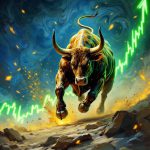Is the World Economy Collapsing? Look Past the Panic, Seize the Gain
“When chaos reigns, the wise see opportunity; when panic prevails, only fools ask if the world is collapsing.”
March 22, 2025
Today’s world economy is often painted as a crumbling edifice, a house of cards teetering on the brink of collapse. Every headline screams doom and gloom, every pundit warns of the inevitable spiral into chaos. Yet, amid the clamour of dire predictions, a subtle truth emerges: the crisis is not a death knell but rather a gateway to untold opportunity. In times of economic upheaval, the landscape is littered with discarded fears—but also with chances to reforge fortunes. The key lies in understanding that while the naive obsess over collapse, the astute know that every crisis carves out niches for those bold enough to seize them.
The Anatomy of Crisis
At its core, a crisis is a period of profound disruption. Markets plunge, economies contract and uncertainty clouds the horizon. But if we pause and reflect, we realize that the factors that evoke fear create a fertile ground for innovation and rebirth. Financial history is replete with examples where the collapse of old structures paved the way for new paradigms. The Great Depression, for instance, shattered established norms but eventually gave birth to unprecedented economic reforms and technological advancements. Similarly, though devastating for many, the global financial crisis of 2008 ushered in a wave of regulatory changes and investment strategies that transformed the market landscape.
In this environment of uncertainty, one must ask not, “Is the world economy collapsing?” but rather, “What opportunities does this crisis present?” For the savvy investor, these tumultuous times are not a signal to retreat but an invitation to recalibrate strategies and embrace the market’s inherent volatility.
Behavioral Psychology: The Hidden Driver
To truly appreciate the dynamics of the crisis, one must delve into behavioural psychology. Our decision-making processes are rarely driven by cold, hard logic alone; they are profoundly influenced by emotion, bias, and instinct. Nobel laureate Daniel Kahneman has long shown that humans are predisposed to react to losses more strongly than to equivalent gains—a phenomenon known as loss aversion. Amid an economic downturn, this bias leads to a herd mentality where fear overrides rational decision-making.
Consider the countless times investors have sold off assets during a market dip, only to watch as those same assets soar once the panic subsides. This reaction is not merely a lapse in judgment but a predictable outcome of our psychological wiring. The key to profiting in such environments is not succumbing to panic but recognising that these emotional responses create opportunities. When fear is at its peak, asset prices become disproportionately depressed, providing an opening for those who can remain calm and think independently.
Mass Psychology: Herds and the Illusion of Safety
The collective behavior of investors during crises can be likened to a frenzied herd—a cacophony of voices that often drowns out the steady beat of rational analysis. In economic stress, the masses tend to cling to familiar narratives, seeking solace in the illusion of safety provided by conventional wisdom. Mass psychology at work is a relentless force that drives market sentiment to extremes.
History shows that while the majority rushes to the exits during downturns, the few who dare to remain stand to gain immensely. This is not to say that contrarian thinking is inherently easy—it requires the discipline to resist the gravitational pull of the herd and the courage to question widely held assumptions. Investors who understand that market sentiment is cyclical and that extremes eventually reverse the trend can position themselves to profit from the inevitable rebound.
Technical Analysis: The Silent Oracle
While psychology explains why markets behave the way they do, technical analysis provides the tools to navigate that behaviour. Chart patterns, moving averages, and momentum indicators offer a visual language through which market trends are communicated. Technical analysis is not a crystal ball but a systematic method of interpreting the signals generated by collective human behavior.
Take, for example, the phenomenon of support and resistance levels. These levels, derived from historical price data, often serve as psychological anchors in the market. When prices approach a support level during a crisis, the fear-induced selling pressure diminishes, creating a floor beneath which prices rarely fall. Savvy investors use these signals to identify buying opportunities amid panic. Similarly, when an asset rebounds off its support level, it is not just a random spike—it is a confirmation that the market’s underlying psychology is shifting, signalling the potential for a broader recovery.
In turbulent times, technical analysis becomes even more critical. It provides an objective framework that helps strip away the noise of sensational headlines and emotional outbursts. By aligning technical signals with understanding behavioural biases, investors can develop a formidable strategy that leverages market volatility instead of falling victim to it.
Crisis = Opportunity: The Contrarian’s Edge
The interplay between behavioural psychology, mass psychology, and technical analysis creates a powerful strategy for navigating crises. When the world economy collapses, the contrarian investor sees an opening. The key is to flip the narrative: rather than asking, “Is the world economy collapsing?” the question should be, “What can I gain from this chaos?”
One of the most vivid illustrations of this principle occurred during the market meltdown of March 2020. As the COVID-19 pandemic unleashed unprecedented panic, global stock markets plunged, wasting trillions of dollars in wealth. Yet, amid the panic, a small cadre of investors saw an opportunity. They recognized that the selling was driven more by fear than by any fundamental change in the value of underlying assets. By systematically buying into the downturn—guided by technical signals that indicated oversold conditions—they could secure positions at a fraction of their previous value. When the market rebounded, those with the discipline to invest during the crisis reaped outsized rewards.
This contrarian approach requires more than courage; it demands a deep understanding of market psychology. It involves recognizing that while the crowd is busy running from perceived disaster, the truly informed investor is quietly accumulating assets at bargain prices. The market, after all, is a living organism—one that cycles through phases of exuberance and despair. The trick is to be there on the right side of those cycles, leveraging the predictable patterns of human behaviour.
The Fusion of Analysis: A Strategic Imperative
The secret to thriving in times of crisis lies in the fusion of behavioural insights and technical precision. In isolation, a seasoned investor does not rely solely on gut instinct or technical charts. Instead, they integrate both realms into a cohesive strategy greater than the sum of its parts. They know that the masses’ irrational exuberance and paralyzing fear create a fertile ground for calculated risk-taking.
For example, consider the role of moving averages in signalling market trends. When a key moving average, such as the 200-day average, is breached during a crisis, it is not merely a technical signal—it is a manifestation of the collective fear that has driven prices to unsustainable lows. Savvy investors monitor these indicators closely, using them as a guide to time their entries and exits. This isn’t about betting on a miracle recovery; it’s about recognizing that markets are driven by cycles and that the most vigorous rebounds often follow the depths of despair.
Similarly, oscillators like the Relative Strength Index (RSI) provide critical insights into market sentiment. An RSI that signals an oversold condition is a beacon to the contrarian investor that fear has reached an extreme and that a reversal is imminent. By combining these technical signals with understanding behavioural biases—such as loss aversion and herd mentality—the strategic investor is equipped to navigate the storm with caution and conviction.
Riding the Market’s Chaos: Wisdom, Cycles, and a Touch of Irony
The market, like life, moves in cycles—growth, decay, and renewal. Every crash carries the seeds of the next boom, making the crisis less of an end and more of a transition. The astute investor doesn’t fear volatility but embraces it, knowing that fortune is often built in the depths of uncertainty. While the masses panic, those who recognize the beauty of the cycle position themselves for the inevitable rebound.
And yet, the spectacle of market doom and gloom is almost comical. Doomsayers shout their predictions of collapse, only to watch the market repeatedly defy them. If they had invested instead of preached disaster, they might have been laughing all the way to the bank. The irony is clear—while fear paralyzes the many, opportunity rewards the few. A well-timed chuckle at the hysteria might be the first step toward a brilliant move.
Chaos, Courage, and Conquest: Turning Market Turmoil into Triumph
Is the world economy collapsing? To the fearful, it appears so. To the bold, it is simply resetting—offering a rare chance to seize what others abandon. History doesn’t reward the timid. It elevates those who see past the panic and recognize that every downturn is a setup for a roaring comeback.
Markets are not playgrounds for the weak-willed. They are battlefields where the masses tremble, and the few who understand the cyclical rhythm of wealth take command. While fear drives most to the sidelines, the true investor thrives in the chaos. The game is brutal but fair: those who master the psychology of the crowd, wield technical analysis like a weapon, and possess the nerve to act when others cower are the ones who emerge victorious.
This is not philosophy; it is fact. Every crash has been a launchpad for those who dared to step in while others fled. Every panic-driven sell-off has handed the greatest rewards to those with steel in their spine. When the world screams collapse, history whispers opportunity. The question is not whether the economy is crumbling—it’s whether you have the fortitude to see beyond the wreckage and claim what the fearful leave behind.
The tide always turns. When it does, those who played it safe will be left watching, full of regret, as those who embraced the storm ride the next great wave to wealth. The market does not reward hesitation—it crowns the relentless, the strategic, the fearless. Will you be among them?
Elevating Thought One Idea at a Time















